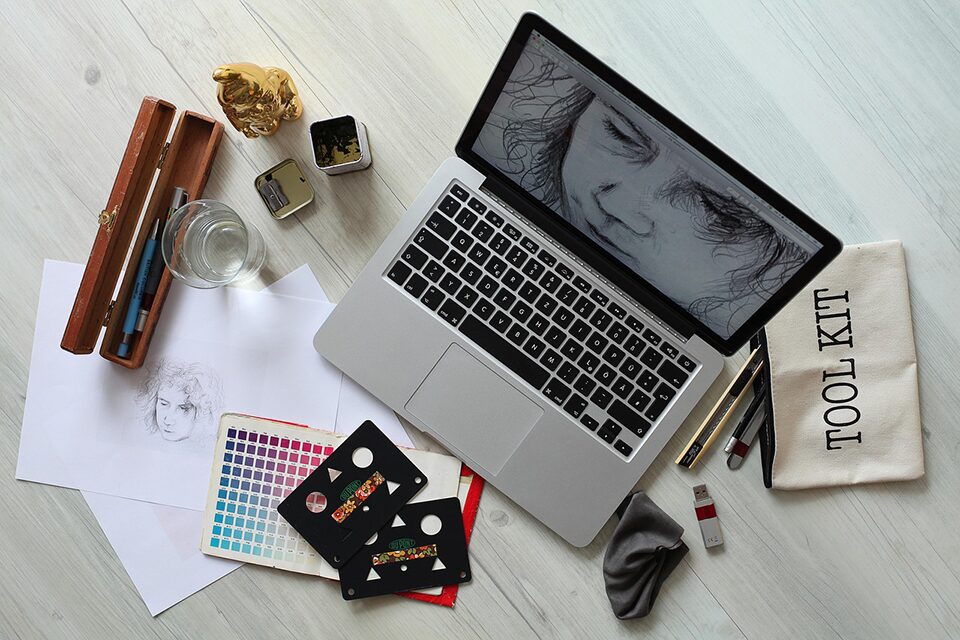Graphic design—especially industry standard software programs like Adobe Illustrator and InDesign—can be daunting when approaching book design, particularly without a previous background in art or graphic design. There are so many facets to keep track of and consider like complimentary colors, tone, contrast, font choice, hierarchy, graphic size, and so on.
When I came to Ooligan in the fall of 2024, I had only a little experience with design—two junior college courses in Adobe InDesign and Illustrator, respectively. I knew coming into the program, I was intrigued by design and wanted to explore the opportunities Ooligan offered in that area. But what I wasn’t prepared for was the imposter syndrome that slowly crept in and eclipsed my creativity at times. I slowly learned to trust myself and, though I did not know the names of many design principles, or consciously realize I was using them, they still managed to become a part of my work.
Below are some of the things that helped me when I was dipping my toes into graphic design without any previous experience.
Look at Other Book Covers or Graphic Design for Inspiration
You pick up more than you think just by observing. You can gain an understanding of current design trends and the types of fonts, colors, and tones associated with different genres. You’ll start to notice what catches your eye and what doesn’t, how the place and weight of words affect legibility, and begin to apply those concepts to your own work, sometimes without even knowing it. Looking at other work is the best way to get inspiration for where to start.
Keep Your Design Simple
Don’t be afraid of white space. Less clutter is better and lets viewers use their imagination to fill stuff in. You don’t need to reinvent the wheel. Search for templates. Canva is great for this, especially as it is more novice and user-friendly (and more intuitive) than Illustrator, even though Adobe also has many templates.
Use a Mood Board
A mood board is great for piecing together what aesthetic you’re aiming for. What colors look good together? What images or objects represent the message or tone you are trying to convey? Mood boards are phenomenal for establishing the overall vibe of a piece, which is a great place to start if you’re feeling overwhelmed by staring at a white screen.
Trust Your Eye
You can tell what looks good and what doesn’t. When in doubt, rely on your senses and feelings when you look at your work and have them inform your decisions. I guarantee you more often than not, you’ll unintentionally have used a design principle—they’re around because people agree they work well together to create a unified image and convey a message. You will have picked up these things knowingly or unknowingly from the world around you: advertisements, movie posters, album covers, book covers, event posters, and Instagram posts. Your eye automatically reacts to things like symmetry and contrast, so relax and follow those basic instincts.
Get Feedback from Peers
Everyone has different opinions and perspectives, so it’s good to get a multitude of advice.
Watch Tutorials
Youtube, LinkedIn Learning, and Adobe. YouTube is a fantastic source for free tutorials. If you have an Adobe subscription, there are tutorials under Adobe Learn, where they teach you the basics of Illustrator and InDesign. In addition, LinkedIn Learning is a great resource—however, you must pay for a subscription to access it. Some public libraries—like the Multnomah Library—offer access to LinkedIn Learning through them if you have a library card, so it’s worth checking out.
Just Have Fun
Try things out, mess around, and have fun like you’re a kid again in Microsoft Paint. Don’t be afraid of the result and fool around with different tools and the effects they can have. Practicing with these tools is the best way to get familiar with them and learn shortcuts.
I believe the essential thing is to not be afraid to play around and mess up. Experimentation is fun and the best way to learn. For more information you can go directly to the source: Adobe Learn, which provides helpful tutorials and articles to peruse.
Back Matter
https://www.adobe.com/learn/illustrator?locale=en&learnIn=1
- Adobe tutorials for Illustrator
https://www.adobe.com/learn/indesign?learnIn=1
- Adobe tutorials for InDesign
https://www.adobe.com/express/learn/blog/demystifying-graphic-design-with-10-tips-for-non-designersAdobe article “Demystifying graphic design with 10 tips for non-designers”

